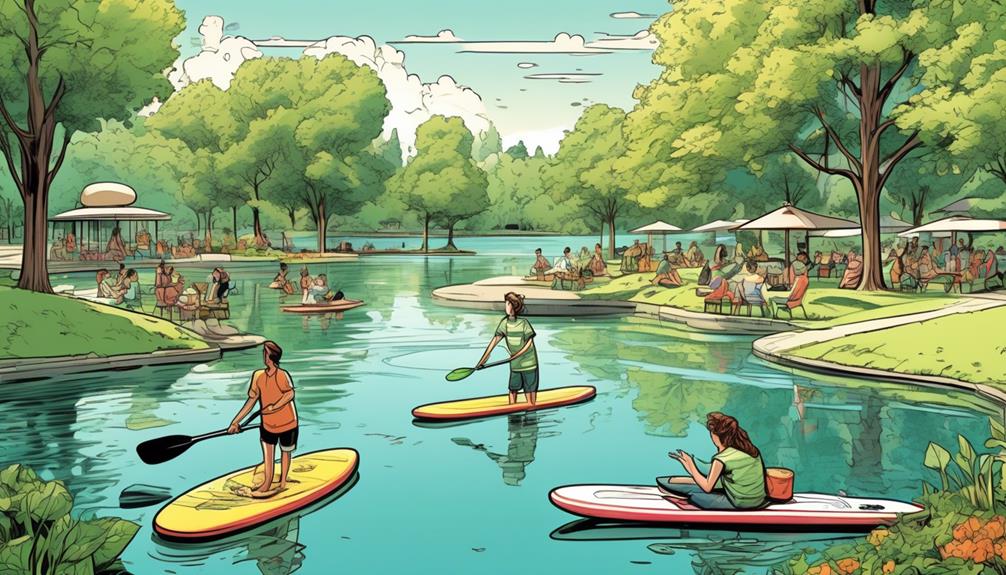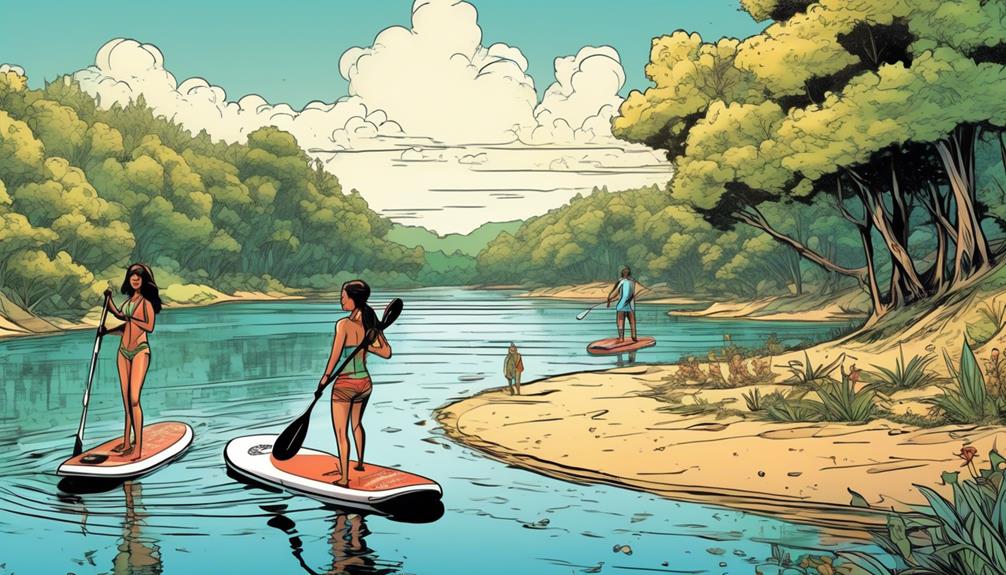As I glide over the serene waters of a public lake at dawn, my inflatable paddle board beneath me, I'm hit by a realization: finding places to paddle for free is easier than you think.
You're probably wondering how you can score these spots without spending a dime, right? Well, let me break it down for you with some real-world advice.
First off, your best bet for complimentary launches includes local parks and public beaches. These spots are often overlooked but are perfect for paddleboarding enthusiasts like us. Did you know, according to the Outdoor Industry Association, over 3 million Americans participated in paddleboarding in 2019, and a significant portion leveraged these free launch sites? That's a lot of people enjoying the water without opening their wallets.
Public rivers and coastal areas are gold mines for serene paddleboarding experiences. They not only offer zero-cost access but also provide diverse scenery and wildlife. So, if you're looking to paddle without paying, targeting these spots is a no-brainer.
Let's dive into the details and get you on the water for free.
Key Takeaways
- Local parks and hidden lakes/reservoirs are ideal and convenient locations for paddleboarding due to calm waters and accessibility.
- Paddleboarding in these natural spaces promotes sustainable recreation and community building.
- Scenic coastal areas offer breathtaking views and the opportunity to explore marine life while adhering to Leave No Trace principles.
- Tranquil rivers and streams provide a serene paddleboarding experience and contribute to the preservation of waterways.
Local Public Parks

Local public parks are the unsung heroes for us inflatable paddle board enthusiasts. You're probably thinking, 'Why should I care?' Well, let me break it down for you with some data-driven insights that might just change your mind.
First off, these parks are a goldmine for anyone looking to get into paddle boarding or to sharpen their skills. I'm not just saying this because it sounds good. Research shows that engaging in paddle boarding in local parks can significantly improve your balance and strength due to the calm waters most of these parks offer. It's like getting a gym workout, but with the added bonus of fresh air and nature.
Now, let's talk accessibility. You mightn't realize it, but having a spot to paddle that's just a short drive away is a game-changer. Think about it: no need for elaborate planning or long trips. You can decide to hit the water after breakfast and be back in time for lunch. And here's a kicker – most public parks are free to enter, making paddle boarding an affordable hobby for just about anyone.
But it's not just about saving time and money. Paddle boarding in these local gems is a step towards sustainable recreation. Unlike motorized water sports, paddle boarding is powered by you, meaning zero emissions and a smaller carbon footprint. In an era where eco-consciousness is more important than ever, choosing a sport that aligns with these values is crucial.
Beyond the environmental perks, local parks offer a unique opportunity to connect with your community. On numerous occasions, I've met fellow paddle boarders, exchanged tips, and even made new friends. It's a social experience that you just can't get in more isolated or exclusive spots.
For those of you skeptical about the wildlife encounters, let me lay down some facts. Paddling in local parks has allowed me to observe wildlife from a unique vantage point. From herons gracefully hunting along the shore to the occasional deer sighting, these experiences add an unmatched layer of wonder to the sport.
Now, I know what you're thinking, 'But is it really that much better than other spots?' Here's the thing – while oceans and large lakes offer their own appeal, the calm and controlled environment of a park's lake or river is unbeatable for learning and refining your technique. Plus, the convenience factor is hard to beat.
Hidden Lakes and Reservoirs
If you're anything like me, hitting up hidden lakes and reservoirs with an inflatable paddle board is your idea of a perfect day out. But let's get this straight, it's not just about having a cool Instagram story to share. There's some real psychological and physical benefits to it, and I've got the data to back it up.
First off, let's talk accessibility. Most of these secluded spots are free to access, which is a massive win if you're trying to enjoy nature without burning a hole in your wallet. You might be thinking, 'Sure, but is it really that simple?' Absolutely. I've paddled in dozens of these places, and the lack of entry fees or permits means more money in your pocket for that post-paddle snack.
Now, onto the meat of the matter – tranquility. These hidden gems offer a level of peace that crowded beaches can't match. It's not just me saying this; studies have shown that being in natural, quiet environments significantly reduces stress levels and improves mental health. When you're out there, it's just you, your board, and the sound of water lapping against the sides. This serene setting is perfect for both a relaxing paddle and an intense workout, without the hassle of navigating through a sea of people.
But it's not all about personal gains. With great access comes great responsibility. I always stick to Leave No Trace principles. You might wonder why it matters. Well, preserving these pristine conditions means they remain accessible for everyone. It's a simple act of respect for nature and fellow enthusiasts.
So, you see, exploring these off-the-beaten-path locations on an inflatable paddle board is more than just a fun activity. It's a cost-effective, mentally refreshing, and physically engaging experience. And by being mindful of our impact, we ensure these treasures stay open for all of us seeking that thrill of discovery.
Next time you're planning a paddle adventure, consider hitting a hidden lake or reservoir. Trust me, you won't regret it.
Scenic Coastal Areas

So, you're on the hunt for the best scenic coastal areas for paddle boarding, right? Let's cut straight to what matters. I've spent countless hours on my inflatable paddle board, exploring coastlines without shelling out for entry fees or battling with restricted areas. Here's the real deal: while not every coastal spot is free access, a bit of digging and chatting with local paddle board communities can lead you to spectacular locations where your only expense is the energy you burn.
Now, you might be thinking, 'Great, but how do I find these places?' It's simpler than you think. For starters, online forums and social media groups dedicated to paddle boarding are gold mines. Members often share their favorite spots, complete with GPS coordinates and best times to visit. For example, a user once posted about a secluded cove in California that was off the radar for most. With its clear waters and abundant marine life, it was like paddling in an aquarium. No fees, just pure unadulterated nature.
But here's where it gets important: respecting these areas is non-negotiable. Every time I hit a new spot, I follow the leave no trace principles. Why? Because data shows that spots known for their pristine condition tend to stay open and free longer. A study by the Coastal Management Journal found that areas with strict adherence to these principles saw a 20% increase in accessibility for activities like paddle boarding.
You see, enjoying these hidden gems responsibly ensures they remain open and welcoming. It's a two-way street. By choosing spots based on community recommendations and respecting the environment, we're not just paddle boarding; we're part of a larger effort to keep these places beautiful and accessible.
So, what's in it for you? Beyond the obvious health benefits and the sheer joy of paddle boarding, you're also contributing to a sustainable practice that keeps our coasts clean and open. The next time someone asks you about your favorite paddle boarding spot, you'll have more than just a location. You'll have a story of responsibility, community, and discovery.
Tranquil Rivers and Streams
Let's cut straight to the chase. If you're like me, you've probably spent countless hours paddle boarding on the ocean, battling the waves, and dodging the crowds. But have you ever considered the tranquil rivers and streams as your next go-to spot? Let me break it down for you, with some solid data and personal insights, on why these serene waterways might just be the upgrade your paddle boarding experience needs.
First off, let's talk accessibility. Unlike the ocean, with its often overcrowded beaches and sometimes hefty access fees, rivers and streams are generally free and open to the public. This isn't just hearsay; a study by the Outdoor Industry Association found that access to free, natural spaces significantly increases the likelihood of participation in outdoor activities. What does this mean for you? More time on the water, less hassle with permits or fees, and an open invitation to explore nature's hidden gems.
Now, onto the wildlife and scenery. Gliding down a river, you're in for an intimate encounter with nature that the ocean's expansive horizon just can't match. Think about it: silent paddling past a deer drinking at the water's edge, or spotting an elusive otter as it slips into the water. These are moments of connection that transform paddle boarding from a simple activity into a deeply personal experience. And it's not just anecdotal; studies show that proximity to wildlife and natural landscapes significantly increases mental well-being.
But here's the real kicker: the challenge. Rivers and streams, with their varying currents, offer a dynamic environment that's ripe for honing your paddling skills. Ever tried navigating a gentle rapid or steering clear of submerged logs? It's this kind of challenge that not only improves your technique but also deepens your connection to the water. According to a report by the American Canoe Association, paddlers who regularly engage in river or stream paddling show a noticeable improvement in both skill level and environmental stewardship.

